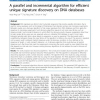Free Online Productivity Tools
i2Speak
i2Symbol
i2OCR
iTex2Img
iWeb2Print
iWeb2Shot
i2Type
iPdf2Split
iPdf2Merge
i2Bopomofo
i2Arabic
i2Style
i2Image
i2PDF
iLatex2Rtf
Sci2ools
BMCBI
2010
2010
A parallel and incremental algorithm for efficient unique signature discovery on DNA databases
Background: DNA signatures are distinct short nucleotide sequences that provide valuable information that is used for various purposes, such as the design of Polymerase Chain Reaction primers and microarray experiments. Biologists usually use a discovery algorithm to find unique signatures from DNA databases, and then apply the signatures to microarray experiments. Such discovery algorithms require to set some input factors, such as signature length l and mismatch tolerance d, which affect the discovery results. However, suggestions about how to select proper factor values are rare, especially when an unfamiliar DNA database is used. In most cases, biologists typically select factor values based on experience, or even by guessing. If the discovered result is unsatisfactory, biologists change the input factors of the algorithm to obtain a new result. This process is repeated until a proper result is obtained. Implicit signatures under the discovery condition (l, d) are defined as the s...
| Added | 08 Dec 2010 |
| Updated | 08 Dec 2010 |
| Type | Journal |
| Year | 2010 |
| Where | BMCBI |
| Authors | Hsiao Ping Lee, Tzu-Fang Sheu, Chuan Yi Tang |
Comments (0)

